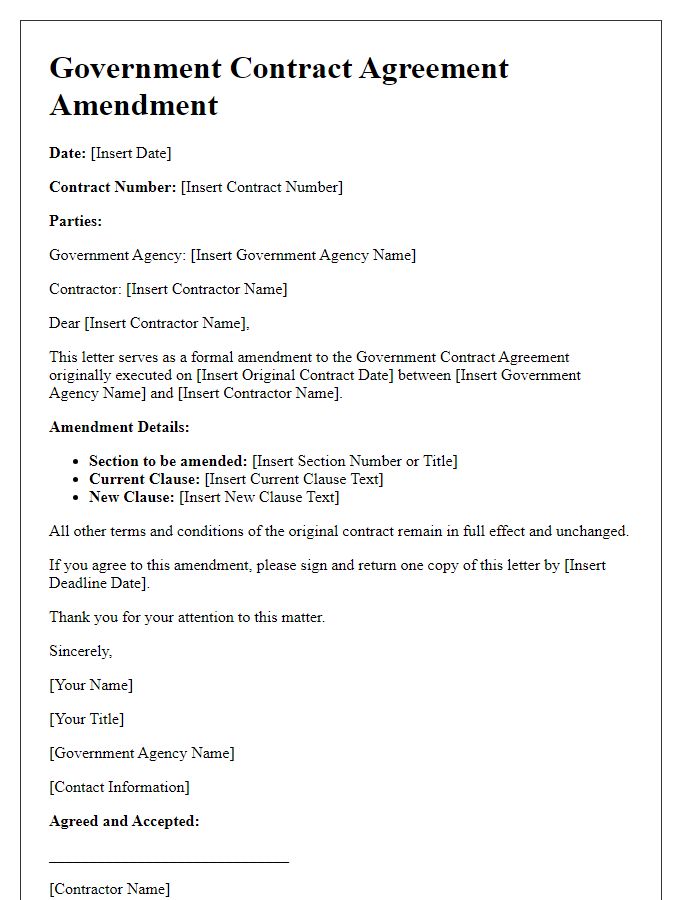Are you looking to navigate the complexities of government contract agreements with ease? Crafting the right letter can set the foundation for a successful partnership and ensure clarity for all parties involved. In this article, we'll delve into essential components and helpful tips that will empower you to draft an effective letter template tailored for government contracts. Read on to discover how to create a winning document that meets all necessary guidelines!

Contract details and parties involved
Government contracts often involve complex agreements between public entities and private businesses, detailing obligations and services. The primary parties include government agencies, such as the Department of Defense, and private contractors, like construction firms or technology providers. Key contract details may include the contract number, award date, total contract value (which can range from thousands to millions of dollars), performance periods, scope of work, compliance regulations, and payment terms. An important aspect is the inclusion of clauses addressing termination rights, dispute resolution mechanisms, and confidentiality provisions, ensuring both parties understand their rights and responsibilities under the agreement. Such contracts must adhere to federal regulations, such as the Federal Acquisition Regulation (FAR) in the United States, ensuring transparency and accountability.
Scope of work and deliverables
The scope of work for the government contract agreement includes the comprehensive outline of tasks, objectives, and expected outcomes to ensure alignment with regulatory standards. Key deliverables will encompass specific milestones such as project implementation timelines, progress reports detailing phases of completion by the end of each quarter, and final documentation that verifies compliance with stipulations set forth in the contract. The location of service provision will primarily be at the designated federal facility in Washington, D.C., while additional requirements may necessitate on-site assessments across various state offices. Collaboration with specialized consultants, scheduled for quarterly review meetings, will facilitate transparency and accountability throughout the contract duration. This structured approach aims to achieve optimal service delivery within the allocated budget and timeframe.
Payment terms and conditions
The payment terms and conditions in a government contract agreement outline the financial responsibilities of both parties involved, typically specifying amounts, methods, and timelines for payment. For example, standard payments might occur on a net 30 basis, meaning the government agency pays within 30 days of receiving an invoice. Milestone payments can also be included, disbursing funds upon completing specific project phases or deliverables. Late payments may incur penalties such as interest rates adjusted to the prime rate plus a specific percentage. Additionally, invoicing procedures must adhere to government regulations, including the use of specific forms or electronic submission guidelines (such as those mandated by the Federal Acquisition Regulation, FAR). Compliance with tax requirements and prevailing wage laws may also be mentioned, ensuring the contractor aligns with local, state, and federal taxation and wage determinations while fulfilling the contract obligations.
Duration and termination clauses
The duration of government contracts typically ranges from one to five years, depending on the scope and complexity of the project. Standard termination clauses allow for mutual agreement termination or termination for cause, such as breach of contract or failure to meet performance standards. Additionally, government entities might stipulate a notice period, usually 30 to 90 days, to allow for an orderly transition. A specific agreement may also outline provisions for early termination upon changes in funding or policy, ensuring compliance with governmental regulations. The contractual terms should clearly define the rights and obligations of both parties in the event of termination.
Compliance and legal requirements
Compliance with government contract regulations encompasses various legal requirements that ensure adherence to federal, state, and local laws. Contracts must align with the Federal Acquisition Regulation (FAR), established in 1984, which governs acquisition processes for government agencies. Stakeholders should be aware of specific provisions, such as the Service Contract Act, mandating prevailing wage rates for service employees. Additionally, contractors must respect the Office of Management and Budget (OMB) Circular A-133, which outlines audit requirements for entities receiving federal funds exceeding $750,000. Agreement documents must also include clauses addressing environmental regulations and affirmative action compliance, ensuring non-discrimination in hiring practices. Understanding these legal frameworks is essential for successful contract execution and to avoid penalties or legal disputes.













Comments